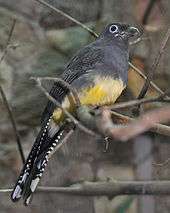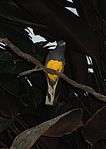Green-backed trogon
The green-backed trogon (Trogon viridis), also known as the Amazonian white-tailed trogon, is a near passerine bird in the trogon family. It is found in tropical humid forests in South America, where its range includes the Amazon, the Guiana Shield, Trinidad, and the Atlantic Forest in eastern Brazil. It formerly included T. chionurus of the Chocó region as a subspecies, but under the common name white-tailed trogon (a name now reserved for T. chionurus).[3]
| Green-backed trogon | |
|---|---|
%2C_male%2C_Restinga_de_Bertioga_-_SP_-_Brasil.jpg) | |
| male at Bertioga, São Paulo State, Brazil | |
.jpg) | |
| female at Bertioga, São Paulo State, Brazil | |
| Scientific classification | |
| Kingdom: | Animalia |
| Phylum: | Chordata |
| Class: | Aves |
| Order: | Trogoniformes |
| Family: | Trogonidae |
| Genus: | Trogon |
| Species: | T. viridis |
| Binomial name | |
| Trogon viridis Linnaeus, 1766 | |
| Synonyms | |
|
Trogon strigilatus [2] | |
Description

This relatively large trogon is 28 to 30 centimetres (11 to 12 in) long.[4] As most trogons, it is strongly sexually dimorphic. In the male the head and upper breast are dark blue (appears blackish in poor light), and the back is green. The lower underparts are orange yellow. The wings are black, vermiculated with white. The undertail is black and white: Each feather has a broad black base and a broad white tip and outer edge.[5] The complete eye-ring is pale bluish. The female green-backed trogon resembles the male, but has a grey back, head and breast, and distinct black-and-white barring mainly to the outer webs of each tail feather.[5]
For comparison, the similar but smaller violaceous trogon has a yellow (male) or incomplete white eye-ring (female), and the male also has barring to the undertail.[5]
There is no overlap in the distribution of the green-backed and white-tailed trogons, but the two can be separated by the undertail pattern: Unlike the green-backed trogon, the male white-tailed trogon only has a very narrow black base to each feather (the undertail appears almost entirely white), and the female mainly has black-and-white barring to the inner webs of each feather (can be difficult to see).[4] The male white-tailed trogon also has a bluer rump than the green-backed trogon.[5]
The song of the green-backed trogon consists of about 20 cow notes that start slow, but accelerate towards the end.[4] The song is slower than the white-tailed trogon, and higher pitched than the black-tailed trogon.[5]
Ecology
They typically perch upright and motionless. Although their flight is fast, they are reluctant to fly any distance. Their broad bills and weak legs reflect their diet and arboreal habits. Green-backed trogons feed mainly on small fruit, supplemented by arthropods – slightly more so in the dry season when fruit are scarce, but even then they seems to be among the most frugivorous trogons in their range.[6] They are consequently more rarely seen to attend mixed-species feeding flocks than other trogons.[7]
It is a resident of humid tropical forests, and it typically is the commonest trogon in its range.[4] It nests in a termite nest or a hole in a rotten tree. The nest is usually if not always built by the female which excavates an upward-sloping tunnel ending in a breeding chamber.[8] The nesting season is apparently mainly during the summer months (June–August).[8] The clutch is typically two or three white eggs. These are incubated for 16–17 days, with a further two weeks to fledging.
Gallery
 Male
Male
References
- BirdLife International (2013). "Trogon viridis". IUCN Red List of Threatened Species. 2013. Retrieved 26 November 2013.CS1 maint: ref=harv (link)
- Zimmer, J.T. (1948). "Studies of Peruvian birds. No. 53. The family Trogonidae". American Museum Novitates. 1380: 1-56 [25-30].
- Remsen, J. V. (2008). Recognize Trogon chionurus as a separate species from Trogon viridis. Archived 2010-06-27 at the Wayback Machine. South American Classification Committee. Accessed 25 January 2011.
- Restall, R. L., Rodner, C., & Lentino, M. (2006). Birds of Northern South America. Christopher Helm. ISBN 0-7136-7243-9 (vol. 1). ISBN 0-7136-7242-0 (vol. 2).
- Ridgely, R. S., & Greenfield, P. J. (2001). The Birds of Ecuador – Field Guide. Cornell University Press. ISBN 0-8014-8721-8
- Pizo, M. A. (2007). The relative contribution of fruits and arthropods to the diet of three trogon species (Aves, Trogonidae) in the Brazilian Atlantic Forest. Revista Brasileira de Zoologia 24(2): 515-517.
- Machado, C.G. (1999). A composição dos bandos mistos de aves na Mata Atlântica da Serra de Paranapiacaba, no sudeste brasileiro. Revista Brasileira de Biologia 59(1): 75-85.
- Cisneros-Heredia, D. F. (2006). Notes on breeding, behaviour and distribution of some birds in Ecuador. Archived 2013-06-26 at the Wayback Machine Bull. B.O.C. 126(2): 153-164.
- ffrench, Richard; O'Neill, John Patton & Eckelberry, Don R. (1991): A guide to the birds of Trinidad and Tobago (2nd edition). Comstock Publishing, Ithaca, N.Y.. ISBN 0-8014-9792-2
- Hilty, Steven L. (2003): Birds of Venezuela. Christopher Helm, London. ISBN 0-7136-6418-5
